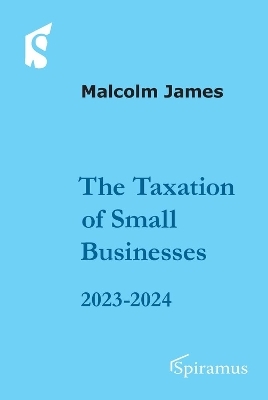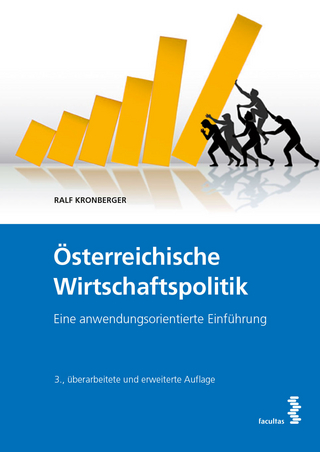
Taxation of Small Businesses 2023/2024
Spiramus Press (Verlag)
978-1-910151-12-9 (ISBN)
- Titel z.Zt. nicht lieferbar
- Versandkostenfrei innerhalb Deutschlands
- Auch auf Rechnung
- Verfügbarkeit in der Filiale vor Ort prüfen
- Artikel merken
The Taxation of Small Businesses 2023-24 is a practical guide to all aspects of direct taxation of small businesses in one volume. It is ideal for sole practitioners and small partnerships, but will be a handy reference guide for all tax advisers. The book aims to give a clear explanation of the relevant legislation and practical advice on ways of minimising clients' tax liabilities and warning against common pitfalls.The sixteenth edition has been updated to incorporate changes as a result of the Finance Act 2023.
Malcolm James is the Head of Department of the Accounting, Economics and Finance Department at Cardiff Metropolitan University and has lectured widely on the subject of taxation on both professional and undergraduate courses. He has also lectured for the Chartered Institute of Taxation and written a number of articles for their journal Tax Adviser and is the Chief Examiner for taxation by the Institute of Financial Services. Before becoming a lecturer he worked for several large firms of accountants and also in industry.
Preface
About the author
Contents
List of abbreviations
Chapter 1. Income Tax Computation
1.1. Aggregation of Taxpayer's Income
1.2. Interest
1.3. Limit on Deductions from Adjusted Net Income
1.4. Payments to Charities
1.5. Personal Allowances Deducted from Net Income
1.6. Computation of Tax
1.7. Tax Reducers
1.8. Tax Retained on Interest, Royalties and Gift Aid donations
1.9. Comprehensive Example
1.10. Death and Separation
1.11. Married Couples – Joint Property
1.12. Minor Children
1.13. High Income Child Benefit Charge
Chapter 2. Taxation of Trading Income
2.1. Introduction
2.2. Statutory Definitions of Trading
2.3. Statutory Trades
2.4. Case Law
2.5. Gambling and Speculation
2.6. Illegal Activities
2.7. Individuals Trading in Shares
2.8. Definition of Trading – National Insurance
2.9. Mutual Trading
2.10. Election to Use Cash Basis
2.11. Capital and Revenue Receipts
2.12. Receipts not Received in Course of Trade
2.13. Other Receipts
2.14. Capital and Revenue Payments
2.15. Expenditure Incurred in the Course of a Trade
2.16. Duality of Purpose
2.17. Repairs and Maintenance
2.18. Replacement of Assets
2.19. Depreciation and Amortisation
2.20. Subscriptions and Donations
2.21. Sponsorship
2.22. Bad Debts
2.23. Provisions
2.24. Payments to Employees & Appropriations of Profit
2.25. Entertainment
2.26. Gifts to Customers and Samples
2.27. Gifts to Educational Establishments and Charities
2.28. Cost of Leasing Cars
2.29. Legal and Professional Fees
2.30. Fines and Payments Against the Public Interest
2.31. Interest and Bank Charges
2.32. Pre-trading Expenditure
2.33. Indirect Taxation
2.34. Compensation and ex gratia Payments to Former Employees
2.35. Redundancy Payments
2.36. Removal Expenses to New Business Premises
2.37. Premiums for Insurance
2.38. Payments to Employees for Restrictive Undertakings
2.39. Staff Training and Development
2.40. Counselling Courses in Connection with Termination of Employment
2.41. Payments to Secure Release from Unprofitable Contracts
2.42. Payments to Political Parties
2.43. Preservation of Goodwill
2.44. Payments on the Cessation of Trade
2.45. Post-cessation Expenditure
2.46. Rent
2.47. Lease Premium
2.48. Patents and Intellectual Property
2.49. Telephone
2.50. Business Rates and Council Tax
2.51. Security Expenditure
2.52. Loan Guarantee Payments
2.53. Use of Home
2.54. Website Expenditure
2.55. Expenses Connected with Foreign Trades
2.56. Valuation of Stock
2.57. Overseas Aspects of Trading
Chapter 3. Capital Allowances on Plant and Machinery
3.1. Introduction
3.2. Definition of Plant and Machinery
3.3. Assets Deemed to be Plant and Machinery
3.4. Definition of Expenditure
3.5. Date of Expenditure
3.6. Disposal of Assets
3.7. Allowances
3.8. Calculation of Capital Allowances
3.9. Short-life Assets
3.10. Cessations and Successions
3.11. Hire Purchase and Leasing
3.12. Fixtures
3.13. Disposal of Fixtures
3.14. Anti-avoidance
Chapter 4. Other Allowances
4.1. Business Premises Renovation Allowance
4.2. Patents
4.3. Know-how
Chapter 5. Basis Periods
5.1. Current Year Basis (CYB)
5.2. Opening Year Rules
5.3. Closing Year Rules
5.4. Tax Planning on Commencement
5.5. Tax Planning on Cessation
5.6. Change of Accounting Date
5.7. Period Less than 12 Months
5.8. Period More Than 12 Months
5.9. Two Accounting Dates in Tax Year
5.10. No Accounting Date in Tax Year
5.11. Transitional Overlap Relief
5.12. Changes in Size and Nature of Operations
5.13. Death of Trader
5.14. Mergers and Demergers
5.15. Date of Commencement and Cessation
5.16. Successions
5.17. Trader Becoming, or Ceasing to be, UK Resident
Chapter 6. Trading Losses
6.1. Introduction
6.2. Offset Against Future Trading Income
6.3. Transfer of Business to a Company
6.4. Offset Against Total Income and Carry-back
6.5. Offset Against Capital Gains
6.6. Losses in the Early Years of Trading
6.7. Terminal Loss Relief
6.8. Tax Planning and Loss Relief
6.9. Restriction of Loss Relief
6.10. Late Claims
Chapter 7. Property Income
7.1. Introduction
7.2. Basis of Assessment
7.3. Dilapidations
7.4. Lease Premiums
7.5. Sale with Right of Conveyance
7.6. Expenditure Deductible
7.7. Sea Walls
7.8. Mutual Business
7.9. Relief for Capital Expenditure
7.10. Losses
7.11. Furnished Holiday Lettings
7.12. Rent a Room Scheme
Chapter 8. Employment and Self-employment
8.1. Introduction
8.2. Benefits of Self-employment
8.3. Definition of Employment and Self-employment
8.4. Tests for Employment
8.5. Workers Supplied by Agencies
8.6. Non-executive Directors
8.7. Self-employment or a Number of Separate Employments
8.8. Provision of Services Through an Intermediary – Income Tax
8.9. Managed Service Companies
8.10. National Insurance – Deemed Employment
8.11. National Insurance – Deemed Self-employment
8.12. National Insurance – Persons Deemed not to be Employed
Chapter 9. Employment Income
9.1. Income Tax – Introduction, Charging Legislation and General Definitions
9.2. National Insurance Contributions – Charging Legislation and General Definitions
9.3. Income Tax and National Insurance – a Comparison
9.4. Time of Receipt
9.5. Cash Payments to Employees
9.6. Payments Arising by Reason of Employment
9.7. Payments on Termination of Employment or Variation of Employment Terms
9.8. Damages and Compensation Paid to Employee
9.9. Sick Pay and Sickness and Other Benefits
9.10. Commission, Cashbacks and Discounts
9.11. Tax-free Lump Sum Payments
9.12. Payment of Expenses to Third Parties on Behalf of Employee
9.13. Payments for Clothing
9.14. Directorships Held by Partners
9.15. Payment of Employee's Tax by Employer
9.16. Income Tax – Deduction of Expenses
9.17. Reimbursement of Expenses
9.18. Qualifying Travel Expenses
9.19. Entertainment
9.20. Expenses Incurred by Homeworkers
9.21. Other Deductible Expenses
9.22. Payments and Benefits Exempt from Income Tax and Class 1 National Insurance Contributions
Chapter 10. Benefits in Kind
10.1. Valuation of Benefits in Kind
10.2. Benefits – Definition of Cost
10.3. Lower-paid Employment
10.4. Benefits in Kind and National Insurance Contributions
10.5. Payment of Expenses by Employer
10.6. Gift of Assets to Employees
10.7. Cash Vouchers, Non-cash Vouchers and Credit Tokens
10.8. Payment Made to a Registered Pensions Scheme for the Benefit of Two or More People
10.9. Waiver of Loan
10.10. Job-related Accommodation
10.11. Assets Available for Private Use
10.12. Expenses Connected with Living Accommodation
10.13. Cars
10.14. Fuel for Private Use
10.15. Pool Cars and Vans
10.16. Vans and Heavier Commercial Vehicles
10.17. Emergency Vehicles
10.18. Beneficial Loans
10.19. Scholarships
10.20. Relocation Packages and Guaranteed Selling Price Schemes
10.21. Medical Treatment and Medical Insurance
Chapter 11. National Insurance Contributions
National Insurance Contributions and Employees
11.1. Earnings Period
11.2. Aggregation of Earnings
11.3. Rate of Class 1 National Insurance Contributions
11.4. Class 1A Contributions
11.5. Calculation of Contributions
11.6. Class 1A Charge Where Benefits Provided by Third Parties
11.7. Earners over Pensionable Age
11.8. Notional Payments of Class 1 Contributions
11.9. Annual Maximum Contributions
National Insurance Contributions and the Self-Employed
11.10. Class 2 Contributions
11.11. Class 4 Contributions
Chapter 12. Pensions
12.1. Introduction
12.2. Scope of Regime
12.3. Registration of Pension Schemes
12.4. Payments by Registered Pension Schemes
12.5. Pension Payments
12.6. Contributions
12.7. Purchase of Shares in Sponsoring Employer
12.8. Loans to Employers
12.9. Unauthorised Payments Charge
Chapter 13. Capital Gains Tax
13.1. Scope of Capital Gains Tax (CGT)
13.2. Exemptions
13.3. Residence
13.4. Capital Losses
13.5. Offset of Trading and Other Losses against Capital Gains
13.6. Capital Gains Tax Rate
13.7. Disposal Consideration
13.8. Date of Disposal
13.9. Allowable Costs
13.10. Indexation Allowance
13.11. Taper Relief
13.12. Assets Owned at 31 March 1982
13.13. Married Couples and Civil Partners
13.14. Disposal to Connected Parties
13.15. Valuation of Assets
13.16. Negligible Value Claim
13.17. Value Shifting
13.18. Disposal by Way of Security
13.19. Hire Purchase Transactions
13.20. Appropriations to and from Trading Stock
13.21. Series of Transactions
13.22. Options
13.23. Debts
13.24. Compensation
13.25. Asset Derived from another Asset
13.26. Location of Assets
13.27. Chattels and Wasting Assets
13.28. Part Disposals
13.29. Leases
13.30. Loss or Destruction of Asset
13.31. Restoration of Assets
13.32. Replacement of Business Assets
13.33. Gift Relief
13.34. Transfer of Assets to a Limited Company
13.35. Entrepreneurs' Relief
13.36. Losses on Loans to Traders
13.37. Loan Guarantees
Chapter 14. Corporation Tax
14.1. Scope of Corporation Tax
14.2. Trading income
14.3. Loan relationships
14.4. Intangible Fixed Assets
14.5. Derivative Contracts
14.6. Property income
14.7. Chargeable gains
14.8. Indexation Allowance
14.9. Indexation and Losses
14.10. Assets Owned at 31 March 1982
14.11. Assets Owned at 6 April 1965
14.12. Rollover Relief
14.13. Dividends Received
14.14. Payments to Charities
14.15. Distributions
14.16. Chargeable Accounting Periods
14.17. Computation of Tax Liability
14.18. Corporation Tax – Interaction with Income Tax
14.19. Losses and Corporation Tax
14.20. Groups and Consortia
14.21. Close Companies
14.22. Companies with Investment Business
14.23. Close Investment-holding Companies
14.24. Demergers
14.25. Purchase of Own Shares
Chapter 15. Incorporation, Disincorporation and Choice of Business Medium
15.1. Introduction
15.2. Incorporation
15.3. Disincorporation
15.4. Disincorporation Relief
15.5. Choice of Business Medium
15.6. Comparison of Tax Treatment of Companies and Sole Traders
15.7. Salary vs Dividends
Chapter 16. Special Classes of Taxpayers
16.1. Construction Industry Scheme
16.2. Farmers and Market Gardeners
16.3. Authors, Artists and Composers
16.4. Actors, Musicians and Entertainers
16.5. Entertainers – Other Workers
16.6. Builders
16.7. Care Providers
16.8. Barristers
16.9. Bookmakers
16.10. Breweries and Licensed Premises
16.11. Doctors and Dentists
16.12. Motor Dealers – Valuation of Used Vehicle Stocks
16.13. Fishermen
16.14. Franchising
16.15. Solicitors
16.16. Sub-postmasters
16.17. Video and DVD Traders
16.18. Clubs, Societies and other Mutual Organisations
16.19. Charities
16.20. Credit Unions
16.21. Friendly Societies
16.22. Housing Associations
16.23. Self-build Societies
Chapter 17. Partnerships
17.1. Definitions
17.2. Limited Partnerships
17.3. Limited Liability Partnerships
17.4. Allocation of Profits
17.5. Assessment of Partnerships
17.6. Other Income of Partnership
17.7. Non-trading Partnerships
17.8. Post-cessation Receipts
17.9. Losses
17.10. Notional Losses
17.11. Mergers and Amalgamations
17.12. Restriction on Loss Relief for Limited and Non-Active Partners
17.13. Partnership Property Income
17.14. Corporate Partners
17.15. Partnerships and Capital Gains Tax
17.16. Roll-over and Gift Relief - LLPs
Index
| Erscheinungsdatum | 04.08.2023 |
|---|---|
| Verlagsort | London |
| Sprache | englisch |
| Maße | 156 x 234 mm |
| Gewicht | 379 g |
| Themenwelt | Recht / Steuern ► Steuern / Steuerrecht |
| Wirtschaft ► Betriebswirtschaft / Management | |
| Wirtschaft ► Volkswirtschaftslehre ► Wirtschaftspolitik | |
| ISBN-10 | 1-910151-12-2 / 1910151122 |
| ISBN-13 | 978-1-910151-12-9 / 9781910151129 |
| Zustand | Neuware |
| Informationen gemäß Produktsicherheitsverordnung (GPSR) | |
| Haben Sie eine Frage zum Produkt? |
aus dem Bereich


